Failure in Hanoi Doesn’t Mean Peace Is Dead
The foundations need to be laid for a long, hard route ahead.
Last week, U.S. President Donald Trump and North Korean leader Kim Jong Un walked away from Hanoi empty-handed. Their failure to sign a deal was shocking, given most of the speculation before the summit had focused on what would be in the deal, not on whether one would be signed. The failed summit has undeniably made negotiations more difficult going forward. But the silver lining is that the two sides now have the time to step back and lay the foundations for a sustainable diplomatic track, which is essential given the long road ahead.

The Hanoi summit, according to Trump, ultimately collapsed because the North Koreans wanted all existing sanctions lifted in exchange for dismantling the Yongbyon test site. A few hours later, Ri Yong Ho, the North Korean minister of foreign affairs, held a news conference and countered that his side had only asked for partial, not full, sanctions relief. He specified that out of the 11 total U.N. sanctions, they wanted the five imposed between 2016 and 2017—especially the parts that have an impact on “peoples’ livelihood” and the “civilian economy”—to be lifted.
Although Ri’s account is technically accurate, in reality the five sanctions he specified are at the heart of the economic pressure campaign on North Korea. These sanctions include measures to cap North Korea’s crude oil and refined petroleum imports; a ban on the export of coal, iron, lead, seafood, textiles, and joint ventures with North Korean partners; and a ban on North Korean laborers from working abroad.
Kim Jong Un’s Big Gamble
It’s unclear why Kim thought Trump would be willing to accept such a maximalist demand, especially given the Trump administration’s political vulnerabilities at home. But Kim clearly lost face after taking a big political gamble and failing to win any economic concessions. As a result, he will likely have less flexibility going forward for two reasons.
First, the failed summit is likely to strengthen hard-liners in Pyongyang who are uncomfortable with Kim’s strategic pivot toward economic development and outreach to the outside world. They can now point to what happened at Hanoi to reinforce the argument that, regardless of Trump’s proclaimed friendship with Kim, the United States and other foreign powers should not be trusted.
Kim will also be constrained by his own words. Only two months ago, he declared in his New Year’s address that if the United States continued to impose sanctions in a “miscalculation of our people’s patience,” he would “find a new way” to defend “the supreme interests” of his state. Having publicly made such a vow to his people, and after being burned in Hanoi, it’s quite likely that Kim will find it politically difficult to return to the negotiating table with a moderated position. In fact, Ri ended his press conference by declaring that North Korea’s “principled position” would never change, even in subsequent negotiations.
Is There A Way Forward?
In addition, there was no indication in Hanoi that the two sides had agreed on next steps or dates for working-level meetings. With such a wide gap in negotiating positions and no pressing deadlines like a summit to work up to, it’s highly possible that talks will stall. In fact, negotiations stalled even after the previous summit when North Korea won significant concessions—including the first-ever summit with a sitting U.S. president and the suspension in U.S.-South Korean military exercises—for vaguely committing to denuclearize the Korean Peninsula and agreeing to return the remains of U.S. soldiers killed during the Korean War.
Obviously, the biggest risk post-Hanoi is that if subsequent working-level talks continue to hit dead ends, both sides will lose patience and goodwill. North Korea could resume nuclear or missile tests or engage in some flagrant behavior to make a statement. In that case, it’s not unrealistic to see a return to, in Trump’s words, “fire and fury.”
Obviously, the biggest risk post-Hanoi is that if subsequent working-level talks continue
to hit dead ends, both sides will lose patience and goodwill.
Yet Trump, at least thus far, has insisted that he and Kim still have a good relationship and a deal could be struck in the future. Other key players in the region will also expend efforts to ensure the situation doesn’t deteriorate to such a point. South Korean President Moon Jae-in will continue to mediate between Pyongyang and Washington, and Beijing will also continue to push for a diplomatic solution.
Silver Linings from Hanoi
But there are some silver linings to the breakdown. The first is that a failed deal is better than a bad deal. And there were many different possible bad deals that could have been signed, such as one that only addressed intercontinental ballistic missiles while leaving U.S. allies vulnerable to shorter-range missiles or one that left a completely open-ended timeline for actual denuclearization, amounting to the recognition of North Korea as a de facto nuclear power.
And by not rushing a deal, the United States now has more time to hold extensive discussions with its Asian allies—especially South Korea—about the difficult questions that will arise on the future purpose and operation of the U.S.-South Korean alliance and the larger U.S.-led alliance network in Asia if and when an end of war declaration is signed.
These kinds of conversations take time and are not just topics for the respective defense departments. Broad discussions among leaders at all levels and across all bureaus, and eventually between leaders and their citizens, are necessary to create a shared vision for how Washington, Seoul, and Tokyo will work together to sustain peace not just on the Korean Peninsula but in the larger region.
The final silver lining is that Washington and Pyongyang now have an opportunity to return to the working level, notwithstanding the challenges discussed above, and set the foundations for a sustainable, long-term diplomatic process.
Two priority items should include: first, hammering out a clearly defined, time-bound road map that ends with a denuclearized North Korea, even if this end state is set many years from now. A final deadline is imperative for reassuring allies that the United States will not allow North Korea to remain a de facto nuclear power indefinitely and for upholding global nonproliferation norms.
Second, an institutionalized mechanism should be created so that when future negotiations stall or fail, there’s a normalized and face-saving way all of the parties can return back to the negotiating table. Without such baseline understandings in place, it will be difficult to sustain momentum in what will be a long journey ahead. And by failing to properly prepare, the United States risks repeating the history of the 1990s and 2000s, when it seemed as if an agreement was around the corner, only to have these efforts fall apart and a worse situation emerge each time.
This article was originally published in Foreign Policy.



